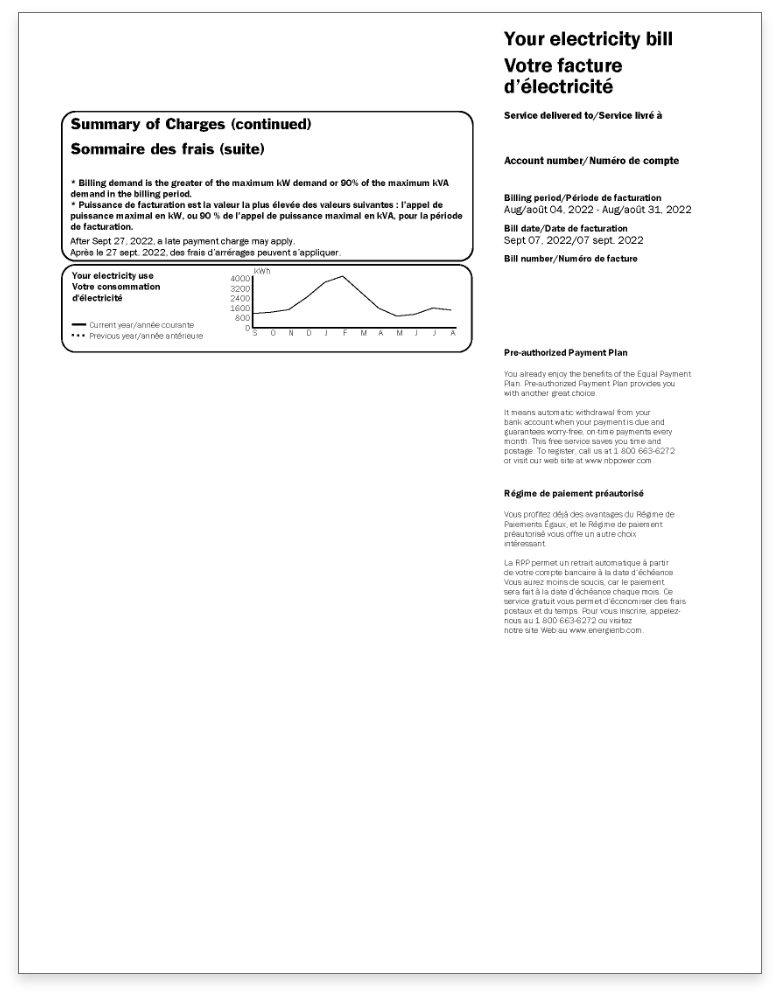Understanding Demand
Determining ways to reduce your energy use goes beyond knowing how much energy your business consumes each month. If your operation is energy-intensive, you need to understand how your operation uses energy each month, in terms of power demand peaks.
There are two separate but related aspects of your monthly bill, consumption and demand. There are ways you can reduce both and lower your overall monthly energy bill and your carbon footprint.
How to read your bill
For General Service and Industrial rates, we measure both energy consumption and energy demand at the meter. Demand is the measure of the maximum power your business might need at any one point and consumption is actual energy used over a period of time.
For example, if your business requires large bursts of energy to operate equipment, NB Power needs to ensure it has the capacity to always meet that peak power demand. How much of that capacity you use appears as a demand charge on your bill. Your usage charge is the total amount of energy consumed over the whole month.
Demand charges are intended to recover the cost of infrastructure (such as power transformers, wires and power plants) required to meet your peak demand.


 |
Consumption Consumption is calculated by taking the total amount of energy used in a billing period. |
 |
Demand Monthly maximum kW demand (measuring power) Monthly maximum kVA demand (measuring power, including reactive power) |
What drives demand?
Understanding the source of your biggest power load is the first step in determining opportunities to reduce your monthly demand charges. Working with an energy advisor, you can identify the peak demand times during the day. From there, you can identify what equipment is contributing to the peak. Analyzing this data can reveal opportunities for modifying your operations to flatten the demand peaks. When you spread out or sequence your power demand peaks, your demand charges will be lower.
Opportunities to sequence power load
One of the simplest ways to lower your demand charge is to “shave the peaks”. “Shaving” means shifting a portion of the electrical load operating at peak times of the day to non-peak times.
For example, instead of operating ten machines at 11:00 a.m., you could reduce your peak power demand by operating three at 9:00 a.m., five at 10:00 a.m. and two at 11:30 a.m. All machines are still operating but not at the same time. This “peak shaving” will be unique to each commercial or industrial customer and is not to be confused with “time of use” rate pricing which NB Power does not currently offer.
Lower demand by improving efficiency
Are there ways to optimize your equipment or systems to operate more efficiently? For example, a compressed air system supplying 90 psi for an application that only requires 50 psi. The system is operating at higher than necessary pressure, wasting energy and increasing running costs.
A variable speed drive may also provide efficiency opportunities in your operation. It is suitable for instances where you can eliminate single speed fan and pump cycling and run longer hours at lower speed.
Evaluate the economics of upgrading energy intensive equipment to more efficient models. Right sizing equipment, including pumps and motors, can have a positive impact on your demand charges as well. Check out our Business Rebate Program to learn more.









